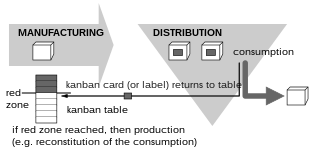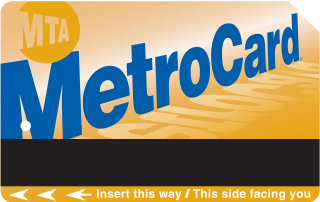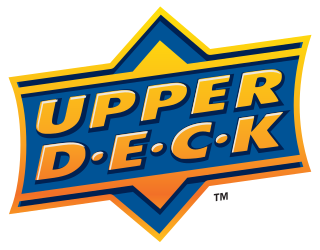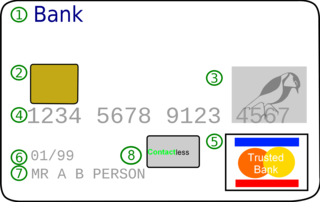Related Research Articles

A punched card is a piece of stiff paper that holds digital data represented by the presence or absence of holes in predefined positions. Punched cards were once common in data processing applications or to directly control automated machinery.

The IBM 650 Magnetic Drum Data-Processing Machine is an early digital computer produced by IBM in the mid-1950s. It was the first mass produced computer in the world. Almost 2,000 systems were produced, the last in 1962, and it was the first computer to make a meaningful profit. The first one was installed in late 1954 and it was the most-popular computer of the 1950s.
Radio-frequency identification (RFID) uses electromagnetic fields to automatically identify and track tags attached to objects. An RFID system consists of a tiny radio transponder, a radio receiver and transmitter. When triggered by an electromagnetic interrogation pulse from a nearby RFID reader device, the tag transmits digital data, usually an identifying inventory number, back to the reader. This number can be used to track inventory goods.

A library catalog is a register of all bibliographic items found in a library or group of libraries, such as a network of libraries at several locations. A catalog for a group of libraries is also called a union catalog. A bibliographic item can be any information entity that is considered library material, or a group of library materials, or linked from the catalog as far as it is relevant to the catalog and to the users (patrons) of the library.

The point of sale (POS) or point of purchase (POP) is the time and place at which a retail transaction is completed. At the point of sale, the merchant calculates the amount owed by the customer, indicates that amount, may prepare an invoice for the customer, and indicates the options for the customer to make payment. It is also the point at which a customer makes a payment to the merchant in exchange for goods or after provision of a service. After receiving payment, the merchant may issue a receipt for the transaction, which is usually printed but can also be dispensed with or sent electronically.

Kanban is a scheduling system for lean manufacturing. Taiichi Ohno, an industrial engineer at Toyota, developed kanban to improve manufacturing efficiency. The system takes its name from the cards that track production within a factory. Kanban is also known as the Toyota nameplate system in the automotive industry.

The MetroCard is a magnetic stripe card used for fare payment on transportation in the New York City area. It is the primary payment method for the New York City Subway, New York City Transit buses and MTA buses. The MetroCard is also accepted by several partner agencies: Nassau Inter-County Express (NICE), the PATH train system, the Roosevelt Island Tramway, AirTrain JFK, and Westchester County's Bee-Line Bus System.

The IBM 305 RAMAC was the first commercial computer that used a moving-head hard disk drive for secondary storage. The system was publicly announced on September 14, 1956, with test units already installed at the U.S. Navy and at private corporations. RAMAC stood for "Random Access Method of Accounting and Control", as its design was motivated by the need for real-time accounting in business.

The Upper Deck Company, LLC, founded in 1988, is a private company primarily known for producing trading cards. Its headquarters are in Carlsbad, California, United States.

Online shopping is a form of electronic commerce which allows consumers to directly buy goods or services from a seller over the Internet using a web browser or a mobile app. Consumers find a product of interest by visiting the website of the retailer directly or by searching among alternative vendors using a shopping search engine, which displays the same product's availability and pricing at different e-retailers. As of 2020, customers can shop online using a range of different computers and devices, including desktop computers, laptops, tablet computers and smartphones.

The tabulating machine was an electromechanical machine designed to assist in summarizing information stored on punched cards. Invented by Herman Hollerith, the machine was developed to help process data for the 1890 U.S. Census. Later models were widely used for business applications such as accounting and inventory control. It spawned a class of machines, known as unit record equipment, and the data processing industry.

Etiquette in Japan forms common societal expectations of social behavior practiced throughout the nation of Japan. The etiquette of Japan has changed greatly over the millennia as different civilizations influenced its culture. Modern Japanese etiquette has a strong influence from that of China and the Western world, but retains many of its unique traditional elements.
Reynold B. Johnson was an American inventor and computer pioneer. A long-time employee of IBM, Johnson is said to be the "father" of the hard disk drive. Other inventions include automatic test scoring equipment and the videocassette tape.

A plugboard or control panel is an array of jacks or sockets into which patch cords can be inserted to complete an electrical circuit. Control panels are sometimes used to direct the operation of unit record equipment, cipher machines, and early computers.
Loyalty marketing is an approach to marketing, based on strategic management, in which a company focuses on growing and retaining existing customers through incentives. Branding, product marketing, and loyalty marketing all form part of the customer proposition – the subjective assessment by the customer of whether to purchase a brand or not based on the integrated combination of the value they receive from each of these marketing disciplines.
The Inventory Information Approval System, or IIAS, is a point-of-sale technology used by retailers that accept FSA debit cards, which are issued for use with medical flexible spending accounts (FSAs), health reimbursement accounts (HRAs), and some health savings accounts (HSAs) in the United States.
Card sorting is a technique in user experience design in which a person tests a group of subject experts or users to generate a dendrogram or folksonomy. It is a useful approach for designing information architecture, workflows, menu structure, or web site navigation paths.

A credit card is a payment card issued to users (cardholders) to enable the cardholder to pay a merchant for goods and services based on the cardholder's accrued debt. The card issuer creates a revolving account and grants a line of credit to the cardholder, from which the cardholder can borrow money for payment to a merchant or as a cash advance. There are two credit card groups: consumer credit cards and business credit cards. Most cards are plastic, but some are metal cards, and a few gemstone-encrusted metal cards.
Magic: The Gathering finance or MtG finance is the financial management and investment as it pertains to the collectibility and playability of the Magic: The Gathering collectible card game. Investments are typically made in single cards whose value are expected to rise over time such as from a shifting metagame or low quantities of cards that may or may not increase in value due to a growing playerbase and their demand. Like the stock market, cards are generally bought at a low price and/or are sold at a higher price during peak demand at a later date. Speculation is common as investors seek to predict which of 20,000+ unique cards will avoid a reprint thereby creating more demand. Speculation also occurs in the selling of card assets when a reprint is expected in an effort to maximize financial gain and minimize loss. Most financing is done through the buying and selling of cards, though some investors have traded their way to cards of higher value, or expected to gain value in the future. Additionally, some speculators have gone as far as manipulating the market by buying up large quantities of a single card in order to artificially inflate a card's price.
Uniterm is a subject indexing system introduced by Mortimer Taube in 1951. The name is a contraction of "unit" and "term", referring to its use of single words as the basis of the index, the "uniterms". Taube referred to the overall concept as "Coordinate Indexing", but today the entire concept is generally referred to as Uniterm as well.
References
- Crosby, Kip; Elbaum, Max (April–June 1994). "Just Like the Golden Gate Bridge: Rey Johnson and Jack Harker talk about RAMAC". The Analytical Engine. 1 (4): 4–5. ISSN 1071-6351. Archived from the original on 2007-04-07. Retrieved 2007-06-22.
- Anderson, Arthur O. (2001). "Reynold B. Johnson: 1906–1998". Memorial Tributes: National Academy of Engineering. National Academy Press. 9: 141. ISBN 0-309-07411-8. ISSN 1075-8844 . Retrieved 2007-06-22.